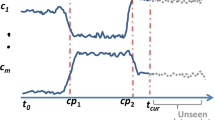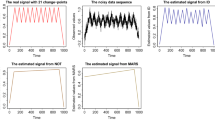Abstract
Detecting change points in time series data is a widely acknowledged challenge with diverse applications, in which the data obtained from measured values is often characterized by complex compositions, and the availability of real data is typically limited. However, current detection algorithms often depend on domain-specific data to achieve better performance or are restricted to analyzing single variant series, limiting their applicability. In this paper, we introduce a novel approach to change point detection that eliminates the requirement for collecting supervised data. Initially, we train a discriminant model using artificially generated synthetic signals comprising a combination of intricate patterns and random noise. This discriminant model is designed to predict the number of change points, and the synthetic data set encompasses a wide range of patterns observed in real data and offers significant advantages in terms of diversity and data volume. The trained discriminant model is then applied in conjunction with the ClaSP method for change point detection. To fully exploit multivariate series information, we propose a simple yet useful weighted-merging method that improves detection performance by aggregating change point votes within each time gap. Experimental results demonstrate the superiority of our Detection Model via Synthetic Signals (DMSS) compared to the original ClaSP method, demonstrating exceptional performance on the Human Activity Segmentation dataset.
Access this chapter
Tax calculation will be finalised at checkout
Purchases are for personal use only
Similar content being viewed by others
References
Michele, B., et al.: Detection of Abrupt Changes: Theory and Application, vol. 104. Prentice Hall, Englewood Cliffs (1993)
Jushan, B.: Estimating multiple breaks one at a time. Economet. Theor. 13(3), 315–352 (1997)
Piotr, F.: Wild binary segmentation for multiple change-point detection. Ann. Stat. 42(6), 2243–2281 (2014)
Shaghayegh, G., Yifei, D., Michael, Y.C.-C., Kaveh, K., Liudmila, U., Eamonn, K.: Matrix profile viii: domain agnostic online semantic segmentation at superhuman performance levels. In: IEEE International Conference on Data Mining, pp. 117–126 (2017)
Amin, S., Yongli, R., Salim, F.D.: Information gain-based metric for recognizing transitions in human activities. Pervas. Mob. Comput. 38, 92–109 (2017)
Hallac, D., Nystrup, P., Boyd, S.: Greedy gaussian segmentation of multivariate time series. Adv. Data Anal. Classif. 13(3), 727–751 (2019)
Talagala, P.D., Hyndman, R.J., Smith-Miles, K.: Anomaly detection in high-dimensional data. J. Comput. Graph. Statist. 30(2), 360–374 (2021)
Patrick, S., Arik, E., Ulf, L.: Clasp-time series segmentation. In: Proceedings of the 30th ACM International Conference on Information & Knowledge Management, pp. 1578–1587 (2021)
Aminikhanghahi, S., Cook, D.J.: A survey of methods for time series change point detection. Knowl. Inf. Syst. 51(2), 339–367 (2017)
Truong, C., Oudre, L., Vayatis, N.: Selective review of offline change point detection methods. Sig. Process. 167, 107299 (2020)
Arik, E., et al.: Human activity segmentation challenge. In: ECML/PKDD 2023 Discovery Challenge (2023)
Vana, P.: Blind Segmentation of Time-Series: A Two-Level Approach. Ph.D. thesis, Delft University of Technology (2015)
Johan, H., Kalle, K., Heikki, M., Johanna, T., Hannu, T.T.T.: Time series segmentation for context recognition in mobile devices. In: Proceedings of IEEE International Conference on Data Mining, pp. 203–210 (2001)
Heli, H.: Segmentation of Time Series and Sequences Using Basic Representations. Ph.D. thesis, Helsinki University of Technology (2007)
Kehagias, A., Nidelkou, E., Petridis, V.: A dynamic programming segmentation procedure for hydrological and environmental time series. Stochast. Environ. Res. Risk Assessm. 20, 77–94 (2006)
Banos, O., Galvez, J.-M., Damas, M., Pomares, H., Rojas, I.: Window size impact in human activity recognition. Sensors 14(4), 6474–6499 (2014)
Jing Yuan, Y., Zheng, X.X., Sun, G.: T-drive: enhancing driving directions with taxi drivers’ intelligence. IEEE Trans. Knowl. Data Eng. 25(1), 220–232 (2011)
Cheng, W., Zhang, X., Pan, F., Wang, W.: HICC: an entropy splitting-based framework for hierarchical co-clustering. Knowl. Inf. Syst. 46, 343–367 (2016)
Prescott, A.R., MacKay David, J.C.: Bayesian online changepoint detection. CoRR (2007)
Taketoshi, M., Yu, N., Masamichi, S., Yushi, S., Tatsuya, H., Tomomasa, S.: Online recognition and segmentation for time-series motion with hmm and conceptual relation of actions. In: IEEE/RSJ International Conference on Intelligent Robots and Systems, pp. 3864–3870 (2005)
Andrew, F., Osmar R.Z.: A parameterless method for efficiently discovering clusters of arbitrary shape in large datasets. In: IEEE International Conference on Data Mining, pp. 179–186 (2002)
Scott Harris, R., Hess, D.R., Venegas, J.G.: An objective analysis of the pressure-volume curve in the acute respiratory distress syndrome. Am. J. Respir. Crit. Care Med. 161(2), 432–439 (2000)
Ermshaus, A., Schäfer, P., Leser, U.: Clasp: parameter-free time series segmentation. Data Min. Knowl. Disc. 37(3), 1262–1300 (2023)
Tianqi, C., Carlos, G.: Xgboost: a scalable tree boosting system. In: Proceedings of the 22nd ACM SIGKDD International Conference on Knowledge Discovery and Data Mining, pp. 785–794 (2016)
Acknowledgements
This work is supported by National Key R &D Program of China (2022ZD0114805), NSFC (61773198, 61921006, 62006112), Collaborative Innovation Center of Novel Software Technology and Industrialization, NSF of Jiangsu Province (BK20200313).
Author information
Authors and Affiliations
Corresponding authors
Editor information
Editors and Affiliations
Rights and permissions
Copyright information
© 2023 The Author(s), under exclusive license to Springer Nature Switzerland AG
About this paper
Cite this paper
Huang, TJ., Zhou, QL., Ye, HJ., Zhan, DC. (2023). Change Point Detection via Synthetic Signals. In: Ifrim, G., et al. Advanced Analytics and Learning on Temporal Data. AALTD 2023. Lecture Notes in Computer Science(), vol 14343. Springer, Cham. https://doi.org/10.1007/978-3-031-49896-1_3
Download citation
DOI: https://doi.org/10.1007/978-3-031-49896-1_3
Published:
Publisher Name: Springer, Cham
Print ISBN: 978-3-031-49895-4
Online ISBN: 978-3-031-49896-1
eBook Packages: Computer ScienceComputer Science (R0)





